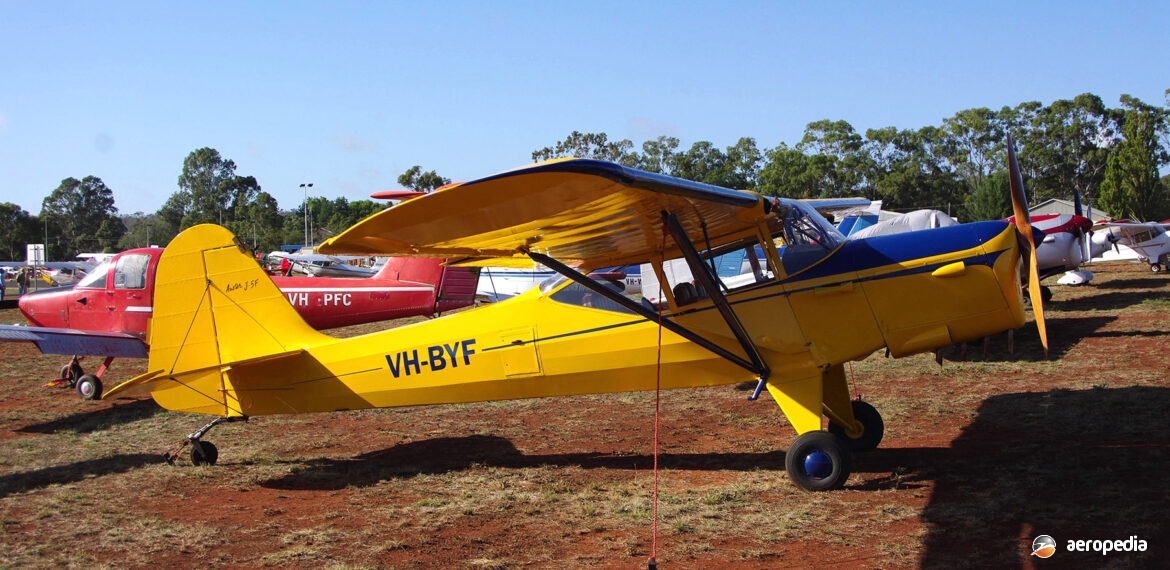Photograph:
Auster J-5F Aiglet Trainer VH-BYF (c/n 2735) at Griffith, NSW in April 2010 (David C Eyre)
Country of origin:
United Kingdom
Description:
Four-seat cabin monoplane
Power Plant:
One 97 kw (130 hp) de Havilland Gipsy Major 1 or 1f four-cylinder in-line air-cooled engine
Specifications:
- Wingspan: 9.75 m (32 ft)
- Length: 7.16 m (23 ft 6 in)
- Height: 1.98 m (6 ft 6 in)
- Wing area: 15.24 m² (164 sq ft)
- Max speed: 212 km/h (132 mph)
- Cruising speed: 180 km/h (112 mph)
- Initial rate of climb: 215 m/min (705 ft/min)
- Service ceiling: 3,810 m (12,500 ft)
- Range: 435 km (270) miles)
- Empty weight: 600 kg (1,323 lb)
- Loaded weight: 885 kg (1,950 lb)
History:
Despite the appellation ‘Aiglet’, the J-5F series was not derived from the J-1B Aiglet. The J-5F was basically a J-5 with a widened and strengthened fuselage to permit the Aiglet Trainer to be fully aerobatic, the only Auster to be fully certified in this role. Some 70 examples of the series were built, a number being registered in Australia and New Zealand.
Several variants were built, including the J-5L VH-BYW (c/n 3136) fitted with a Gipsy Major 10 engine. The J-5R VH-KCK (c/n 3305) combined the Aiglet Trainer fuselage with the Autocar wings (fitted with the improved Aiglet Trainer aileron system). This latter aircraft was destroyed in a crash at Booligal, NSW on 7 December 1961. The J-5Q was a lower-powered version of the J-5R Alpine but only four were built, one becoming VH-UED (c/n 3203) which crashed near Katherine, NT on 6 March 1966; and another became ZK-BLW (c/n 3201).
The J-5F was placed in production in late 1952 and 17 were built for the Pakistan Air Force and five being supplied to Airways Aero Association at Croydon, UK. One G-AMOS (‘Liege Lady’) was used by Mr T Hayhow to set 24 Class C.1b point to point records across Europe, being fitted with a 218 litre (48 Imp gal) long-range tank. However, on 10 April 1953 a forced landing was made in the Austrian Alps.
Several variants were built. The J-5E was produced to overcome problems found by operators of the J-5B in hot temperatures and tropical climates, the power problem being corrected by the installation of a 116 kw (155 hp) Blackburn Cirrus Major 3 engine. The wingspan was reduced to 9.15 m (30 ft 5 in). One machine built was used for air racing by Ranald Porteous and achieved 266 km/h (165 mph). The J-5K, of which one was built G-AMMS (c/n 2745), had a 116 kw (155 hp) Blackburn Cirrus Major 3 engine. The J-5L, of which 28 examples were completed, was powered by a 108 kw (145 hp) Gipsy Major 10 engine and fifteen of these were delivered to the Iranian National Aviation Club in 1958.
One G-AMYI was converted to J-8L configuration by the installation of a Gipsy Major X engine. This model differed in having the flap lever centred on the cabin roof. It seated two or three and had the short 9.75 m (32 ft) wings of the aerobatic J-5F, with empty and loaded weights of 658 kg (1,450 lb) and 975 kg (2,150 lb). This J-8L has been registered in Australia, becoming VH-UYQ (c/n 3151 – ex G-AMYI), being damaged at Bunbury, VIC on 4 March 1980 when it collided with a Cessna 150 (VH-PEA) but was later rebuilt, becoming VH-RIE in May 2007.
Construction was of welded steel-tube fuselage, clad in fabric. The tail surfaces were similarly constructed and externally braced by wire. The mainplanes, like most Austers, were constructed around solid spruce-plank spars and metal stamped ribs. The wing structure was drag-trussed by tubular compression members and X-wire bracing internally, and by VEE-struts of streamlined steel tube externally. A simple tubular steel triangulated undercarriage, sprung by rubber cords in tension, was fitted. Split trailing-edge flaps were operated manually by an overhead lever in the cabin. A steerable tailwheel was fitted with a solid rubber tyre and sprung by a small leaf. However, some owners have replaced this with a small pneumatic tyre for smooth ground running. Differential wheel brakes operated by heel pedals were fitted as standard.
New Zealand registered J-5Fs included: ZK-BBT (c/n 2756); ZK-BBU (c/n 2759); ZK-BBZ (c/n 2772); ZK-BCJ (c/n 3105); ZK-BCK (c/n 3106); ZK-BCQ (c/n 3111); ZK-BDO (c/n 2775 – ex G-AMYE); ZK-BDW (c/n 3000); ZK-BDY (c/n 3109); ZK-BRA (c/n 3110 – ex G-ANAU) which operated with the South District Aero Club; and ZK-BRA (c/n 3110).
Australian registered J-5Fs included: VH-AFS/VH-WDC (c/n 2709 – ex G-AMKF, G-25-1) which crashed at Hughenden, VIC on 17 December 1964; VH-AFT (c/n 2712); VH-ADT (c/n 2713); VH-AFK (c/n 2714) which crashed at Burragorang Valley, NSW on 16 October 1954; VH-AGM (c/n 2717) which crashed near Moorooduc, VIC on 9 September 1971; VH-BWJ/VH-UEA (c/n 2732); VH-BYE (c/n 2733) which crashed landing at Dromona, VIC on 10 March 1969; VH-BYF/VH-SAE (c/n 2735); VH-BYG/VH-WHS (c/n 2736); VH-BYX (c/n 3137) and VH-MPW (c/n 3138).

